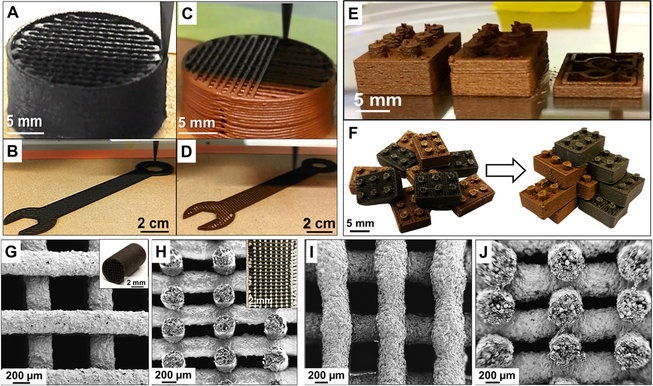A study published in Nature’s Scientific Reports demonstrates tools and bricks 3D printed in inks made from Lunar and Martian like powders.
Conducted by the Shah Tissue Engineering and Additive Manufacturing (TEAM) Lab at Northwestern University, the research is aimed at construction using native materials in resource-limited and extraterrestrial environments.

Preparing a 3D print for space
As an FFF type 3D printer is already in use in zero-gravity conditions on the International Space Station, the Shah Lab chose to concentrate material study on this particular method. In this respect, the lab also ensured the 3D printing process was performed in a pressurized environment to mimic the conditions in space.
For the all-important first layer, the team also used sand and silicon carbide papers on the print bed, which gave stability to successive layers and, after easy removal, could be used multiple times.
3D printing on the moon and mars
A total of two inks were developed in this study. They are made from a recipe based on an existing process developed at TEAM for 3D printing metal alloys, graphene biomaterials, and ceramics, as in the hyperelastic bone research.
Powder is the main ingredient for each – with Lunar Regolith Simulant (LRS) used to make black parts and Mars Regolith Simulant (MRS) for the red.

To the powders, the researchers add a quantity of elastomeric binder, used to ensure the flexibility of a finished 3D print, and a solvent mixture. The low solvent content in the ink actually serves to dissolve the elastomeric “skin” that can form on top of a freshly printed layer of material. The balance between the two substances allows good adhesion between layers, and a “near-seamless” appearance to the surface.
The results, according to the authors, are “rapidly 3D-printed, highly versatile and mechanically elastic composites” that “have the potential to address the need for soft materials off-world.”
Challenge accepted
As the next goal in human-accessible Space Exploration, the Centennial Challenge from NASA has challenged groups and institutions to design habitable structures made from recycled or indigenous materials. The 3D printed “Ice House” design from SEArch (Space Exploration Architecture) and Clouds AO (Clouds Architecture Office) won Phase One of the challenge. The next step is to make such concepts a reality.
As previously reported on 3D Printing Industry, scientific research company Fotec is also using Mars Regolith Simulant for 3D printing in a commission by the European Space Agency.
The full article on Robust and Elastic Lunar and Martian Structures from 3D-Printed Regolith Inks can be read online via Nature. It is co-authored by Adam E. Jakus, Katie D. Koube, Nicholas R. Geisendorfer and Ramille N. Shah.
For more reports on the latest 3D printing research sign up to the 3D Printing Industry newsletter, and follow our active social media sites.
Don’t forget to vote in the first annual 3D Printing Industry Awards.
Tickets for the 3D Printing Industry Awards are also now available here.
Featured images: 3D printed in Mars and Moon dust – tools and bricks from the Shah Lab at Northwestern University. Photo via Shah et al.



